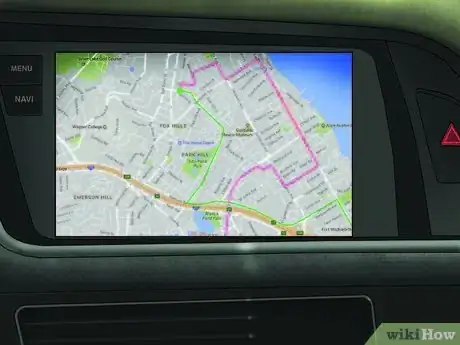This article was co-authored by Kathryn Kellogg. Kathryn Kellogg is the founder of goingzerowaste.com, a lifestyle website dedicated to breaking eco-friendly living down into a simple step-by-step process with lots of positivity and love. She's the author of 101 Ways to Go Zero Waste and spokesperson for plastic-free living for National Geographic.
There are 7 references cited in this article, which can be found at the bottom of the page.
This article has been viewed 95,266 times.
Carpooling makes sense - after all, it can save time, money, and fuel, and it’s good for the environment. But figuring out a sensible arrangement isn't always easy. Sometimes it can feel as though setting up a carpool is more trouble than it's worth. Fortunately, there are ways to avoid common pitfalls, so you can enjoy all the benefits of carpooling without the headaches!
Steps
Finding a Carpool
-
1Check with your company, school, or other organization for carpool resources. One of the easiest ways to set up a carpool is to search for other people traveling to the same destination. Many schools, companies, and organizations maintain websites or send out emails to help commuters connect. Oftentimes large corporations and universities even offer incentives for individuals who commute![1]
- If your university or corporation does not offer commuting services, consider talking to Student Services or Human Resources about setting them up!
-
2Communicate with neighbors to find other commuters. Get the word out to friends and neighbors that you’re looking to set up a carpool. You can use social media, advertise on neighborhood message boards, or even create a flyer to post near your home.[2]
- You want your flyer to catch people's attention, so consider searching for an eye-catching flyer template online or adding your own bright picture of a car!
- The flyer should include basic information like the start and end destinations as well as the time range. You can include your first name, but beware of putting too much personal information on a public flyer.
- Consider creating a new email address specifically for the carpool to avoid advertising your personal contact information.
Advertisement -
3Explore government-sponsored carpool programs. In recent years, governments at many levels have begun to sponsor rideshare programs. Some government-run websites offer links and services to help find commute partners. And some government programs even offer subsidies or other financial incentives for choosing to carpool.[3]
- In the United States, state-run Department of Transportation sites are great places to search for pilot projects that benefit carpoolers.
- Michigan offers commuters in some areas van rentals at a subsidized rate.
- Wisconsin, Colorado, Washington, and Massachusetts also provide vanpool services and financial incentives to residents in certain regions.
-
4Use rideshare websites and apps to connect with commuters. There are an ever-growing number of free and fee-based sites such as Scoop, ToGo, and Zimride that allow you to find fellow carpoolers. To use these resources, you create a profile that includes your commute schedule and destination address. Then you can contact people with similar commutes to coordinate rides.[4]
Setting Expectations
-
1Meet your fellow commuters in person. Especially if you're commuting with strangers, you want to meet with everyone at a public location before getting in a car together! Meeting in person is a great chance to assess whether or not you trust potential carpoolers. It's also an opportunity to discuss expectations and evaluate if you want to proceed as a carpool group.[5]
- Pay attention to red flags during conversation. If someone complains a lot or seems irresponsible, it's probably not a good match.
- If anyone makes you feel unsafe of uncomfortable, don't risk it. Always trust your gut.
-
2Decide who's driving. Discuss if you will rotate drivers, or if one person will drive regularly. Safety should be your primary concern, so it’s important to make sure that whoever agrees to drive has an active license and car insurance that will cover the group.
-
3Select the vehicles for your carpool. Determine whether your group will use personal vehicles, rent a vehicle from a rental car agency, or take advantage of any government subsidized vanpool programs. You want to consider several factors when making this decision.
- Figure out the most fuel efficient option. If one person in the carpool has a gas guzzler and another person has a hybrid, then it might be in the group's best interest to use the hybrid more often. If you can rent a hybrid, that might save you more money than using an inefficient vehicle that someone already owns.
- Consider comfort. You don't want to be packed into a cramped space everyday or find yourself sweating profusely in a car with a broken AC.
- Make sure any vehicle used has an up to date registration and insurance.
- Think about safety concerns. Will there be enough seat belts, does the car have air bags, and has it received regular maintenance?
-
4Determine how costs will be shared. You’ll need to establish a policies for funding your commute. If you are renting a vehicle, you can simply divide the cost of the rental and gas by the total number of commuters. But if individuals drive their own cars, the cost of gas mileage, vehicle depreciation, insurance, and maintenance should be considered.[6]
- You can use an online commute cost calculator to determine the cost of driving for each driver.
- Once you calculate the overall cost to the driver, simply divide that number by the total number of passengers for that day to determine how much everybody owes.
- Agree on payment methods and set payment deadlines.
-
5Decide if your carpool will permit meals. Some people may be planning to eat their breakfast or sip their coffee during the ride, so find out if everyone is comfortable with that idea. Some people may not want to smell other's food, and many drivers like their cars to remain food-free!
-
6Determine if the carpool will allow smoking. This issue can prove truly divisive, so ensure that everyone's on the same page. Many individuals prefer to avoid secondhand smoke, and some people are so sensitive that they don't want to even sit next to an individual who has been smoking earlier in the day.
-
7Pick a music policy. Maybe one person plans on being the carpool DJ while another likes to enjoy a silent ride. You can have different policies for different days, just make sure everyone agrees.
-
8Set boundaries for conversation. You might want to decide which topics--such as politics or work gossip--are off limits. Similarly, you might want to discuss rules for cell phone conversations.
- These conversations may seem a little awkward to have at the outset, but they are necessary to prevent conflicts down the line.
- You can raise this issue in an easygoing way: "How about we set some guidelines for off-limits conversation just to make sure we keep things light? What do you guys say about using the same principle I use with my family at Thanksgiving--avoid intense conversations about politics, work, and religion"?
Establishing a Route and Routine
-
1Pick a fast route. You want to spend as little time commuting as possible, so use online mapping services like Google Maps or Apple Maps to determine the most efficient route. However, remember to adjust for additional factors, which mapping services might not consider.
- As a commuter, you may be eligible for use of an HOV or designated express lane, which can save more time than your mapping service's prediction may suggest!
- Consider purchasing an EZ pass if you need to cross bridges or pass tolls. These save extra time, and several US states offer discounts for carpools.
-
2Select a departure point. Once you decide on your driver and route, you can pick a strategic starting point. Depending upon traffic conditions and where your carpoolers live, it might make sense to have your driver pick up the other passengers, meet at the home of the driver, or join up at a convenient location that’s along the way.[7]
-
3Formulate your schedule. You want to establish meeting or pick up times to make sure things run smoothly. It's a good idea to plan for contingencies.
- Make sure to leave a little extra time in the schedule to allow for routine traffic delays.
- Establish the amount of time the carpool will wait for any late member.
- Include backup plans in case a driver gets sick and can’t drive.
Warnings
- Drivers should check to make sure their insurance coverage will cover all of the passengers in a carpool.⧼thumbs_response⧽
- Take extra caution when carpooling with people you don't know.⧼thumbs_response⧽
References
- ↑ https://www.bestworkplaces.org/pdf/carpool_June07.pdf
- ↑ https://www.thesimpledollar.com/starting-a-carpool/
- ↑ http://www.michigan.gov/mdot/0,4616,7-151-9615_11228---,00.html
- ↑ https://www.nctr.usf.edu/programs/clearinghouse/ridematching-software/
- ↑ http://rideshare.lacounty.gov/carpool/
- ↑ http://www.go-metro.com/how-to-ride/howtoride/savings-calculator
- ↑ https://www.dcccd.edu/slife/commuting/pages/carpooling-tips.aspx











































































